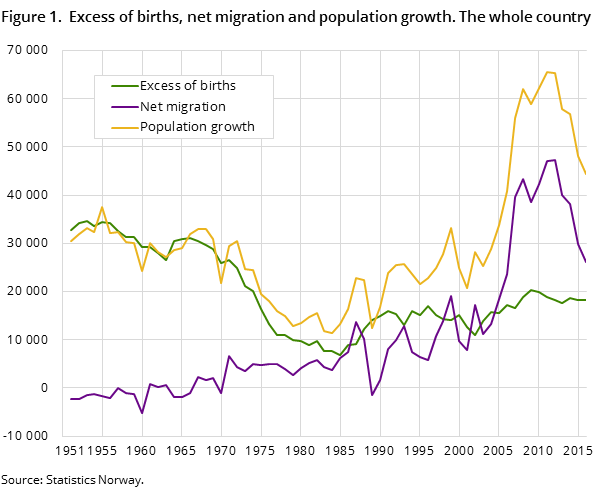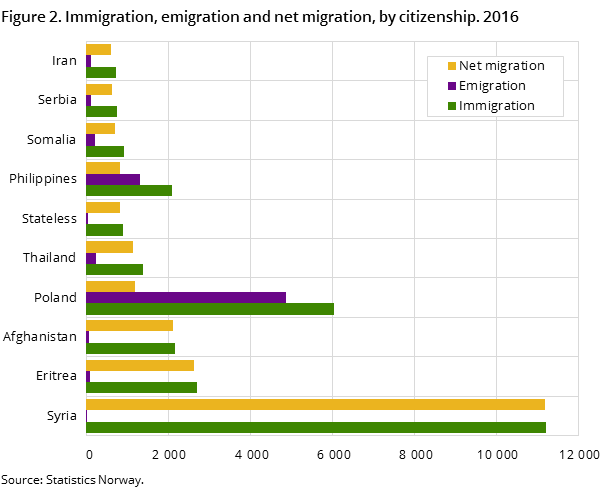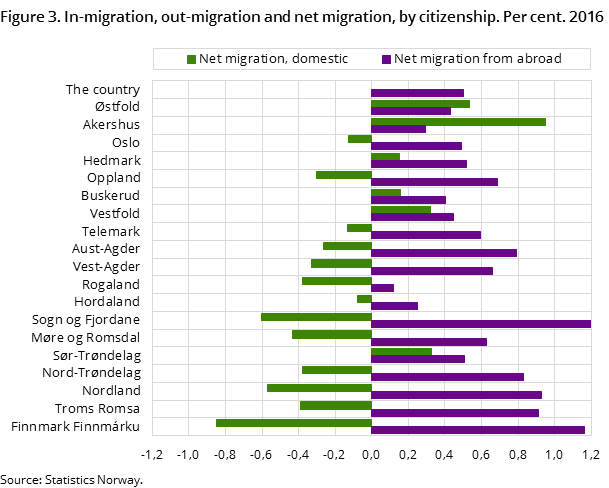Content
Published:
Next release:
Lowest growth since 2006
At the turn of the year, the population totalled 5 258 000, which is a growth of 44 300 in 2016. This growth was lower than in previous years, particularly because of higher emigration. Among those who immigrated, the largest group were from Syria.
| 4th quarter 2016 | 4th quarter 2015 | Changes from same period previous year | |
|---|---|---|---|
| Population at the beginning of the quarter | 5 252 166 | 5 205 434 | 46 732 |
| Births | 13 097 | 13 218 | -121 |
| Deaths | 10 682 | 10 221 | 461 |
| Excess of births | 2 415 | 2 997 | -582 |
| Immigration | 16 170 | 15 829 | 341 |
| Emigration | 12 530 | 10 397 | 2 133 |
| Net migration, immigration and emigration incl | 3 640 | 5 432 | -1 792 |
| Population growth | 6 151 | 8 551 | -2 400 |
| Population at the end of the quarter | 5 258 317 | 5 213 985 | 44 332 |



The number of immigrants with citizenship from non-European countries increased. Last year, 11 200 Syrian citizens immigrated to Norway. Since asylum seekers are not registered as immigrated until they are granted a residence permit, many of the asylum seekers that came to Norway in 2015 are registered as immigrated in 2016. Syrian citizens in 2016 constituted the largest group of immigrants. Few Syrian citizens emigrated from Norway. In terms of net migration, citizens from Eritrea constituted the second largest group. Net migration of Eritrean citizens was 2 600. For persons with citizenship from Afghanistan, net migration was 2 100. Immigration from Eastern Europe is decreasing. The net migration for Polish citizens was 1 200, which is a decline compared to 2015. In 2015, the net migration of Polish citizens was 4 700.
Lower population growth
The population increased by 44 300 persons last year, which was 3 850 fewer than in 2015 and the lowest increase since 2006. Higher emigration was the main reason for this. The net migration from abroad decreased by 3 700 compared to 2015. A total of 66 800 immigrations were registered, which was 500 fewer than the year before. A total of 40 700 persons emigrated from Norway, which was 3 200 more than in 2015, and the highest number ever registered.
Population growth in all counties
The population increased in all counties in 2016 but the increase was lower than in 2015 in 8 of the counties. Densely populated counties such as Oslo, Rogaland and Hordaland had lower growth than in 2015. Oslo had a population growth of 8 400, which is 2 300 lower than in 2015. Rogaland had a growth of 1 800; 2 000 lower than in 2015. In Hordaland, the growth was 1 700 lower than in 2015. Akershus had the highest growth in the population, with an increase of 9 800; 200 higher than in 2015.
All counties had net migration from abroad and six of the counties had an internal migration surplus. The growth in internal migration surplus was highest in Akershus both in absolute numbers and as a percentage. The county had an internal migration surplus of 5 700. Seen in relation to the population, the net migration from abroad was highest in Finnmark and Sogn og Fjordane.
In terms of internal migration and migration from abroad as a whole, Rogaland was the only county to have a negative net migration. Nevertheless, the population of Rogaland saw an increase in 2016 due to a large excess of births.
Increase in life expectancy for men
A total of 40 700 persons died in 2016, about the same as in 2015. Life expectancy for men was 80.6 years. This is an increase of 0.25 years compared to 2015. For women, life expectancy was 84.2 years in 2016. This was the same as last year.
A total of 58 900 children were born in 2016, which is about the same as in 2015. The total fertility rate (TRF) was 1.71; a decline compared to 2015. The total fertility rate was 1.98 in 2009. Since then it has declined. The excess of births was 18 200 in 2016, slightly lower than the previous year.
Clearing-up in the Central Population RegisterOpen and readClose
The Tax Administration continuously updates the Central Population Register to reflect the status of persons who no longer live in Norway. These updates have been standard practice in recent years.
Short-term stays and asylum seekersOpen and readClose
Persons who stay in Norway for less than 6 months are not included in the figures. Asylum seekers are included when they are granted a residence permit. Figures for asylum seekers can be found on the UDI website.
Contact
-
Magnus Haug
E-mail: magnus.haug@ssb.no
tel.: (+47) 40 81 14 91
-
Karstein Sørlien
E-mail: karstein.sorlien@ssb.no
tel.: (+47) 47 70 16 35
-
Linn Krokedal
E-mail: linn.krokedal@ssb.no
tel.: (+47) 95 47 97 47
-
Anders Sønstebø
E-mail: anders.sonstebo@ssb.no
tel.: (+47) 46 66 37 74
-
Espen Andersen
E-mail: espen.andersen@ssb.no
tel.: (+47) 92 61 00 46
-
Statistics Norway's Information Centre
E-mail: informasjon@ssb.no
tel.: (+47) 21 09 46 42
-
Oppdrag befolkningsstatistikk
E-mail: befolkning@ssb.no
